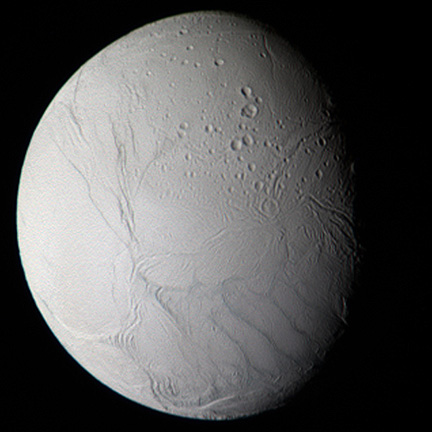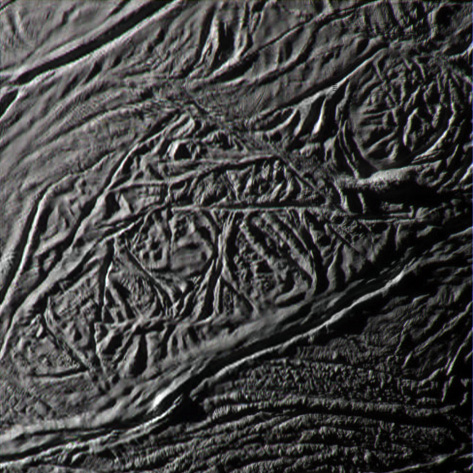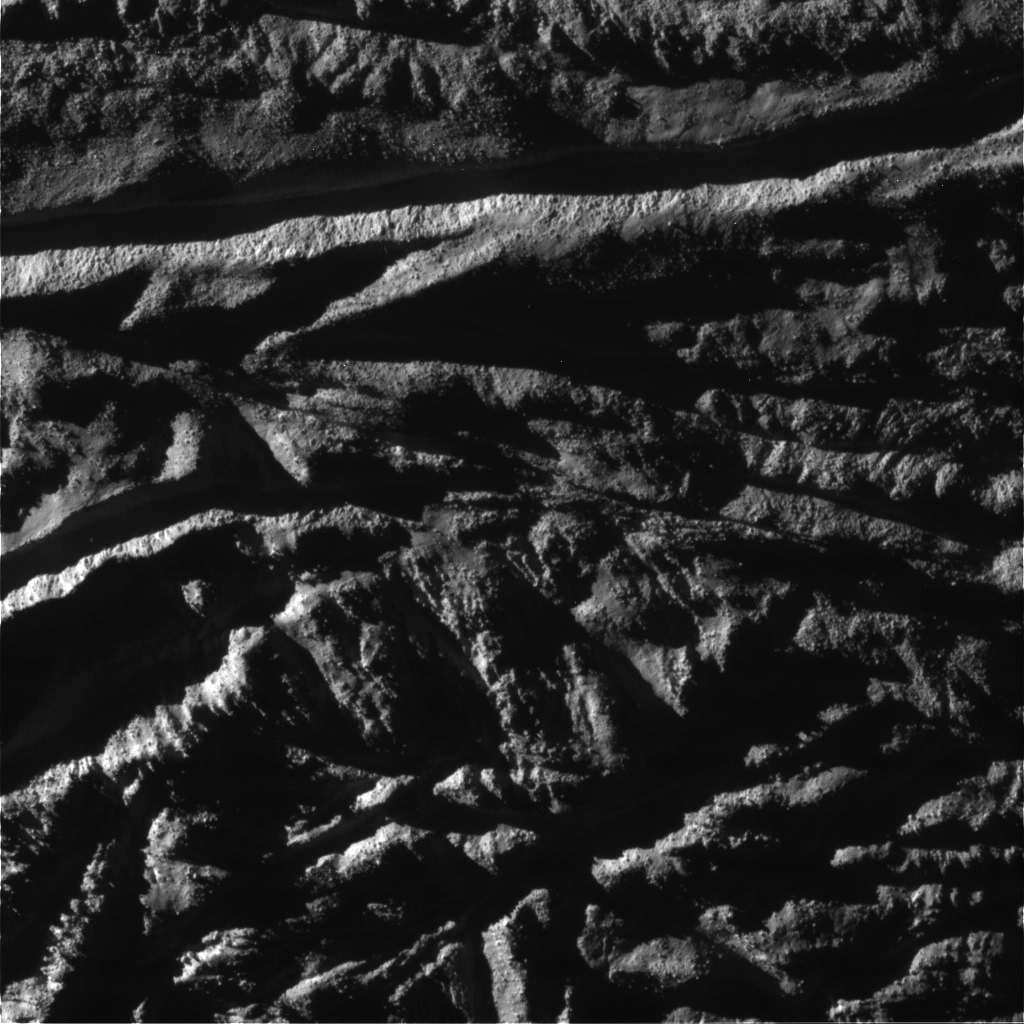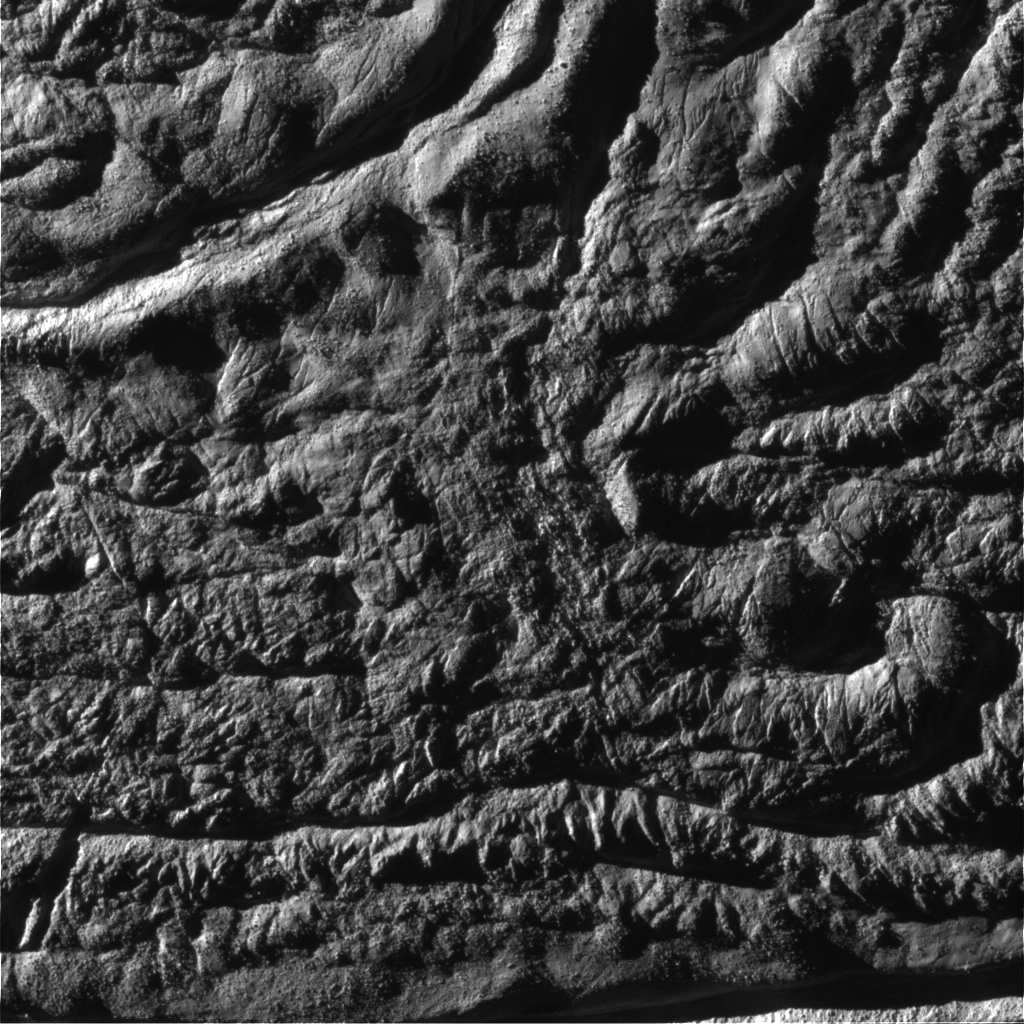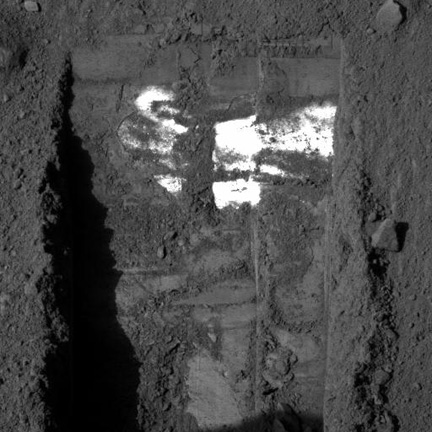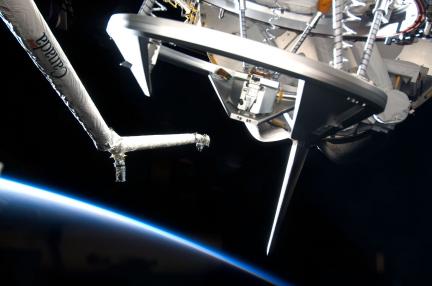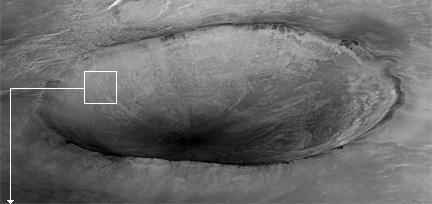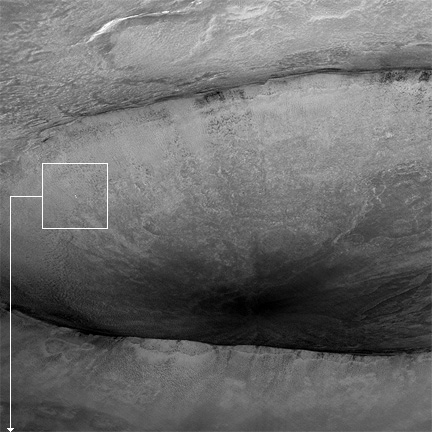 Here is an interesting comparison found on the Japanese Kaguya mission site. The two images shown above are of the Apollo 17 landing site. The top is obviously a photo taken on location by an Apollo astronaut and the lower image is a render from data taken by Kaguya in orbit around the moon. When programmers compile their data to show how the moon looks from the same position as the original Apollo photographer, the results come pretty close to matching. Such a comparison offers an idea of how real other such renders we may see from the mission can be trusted.
Here is an interesting comparison found on the Japanese Kaguya mission site. The two images shown above are of the Apollo 17 landing site. The top is obviously a photo taken on location by an Apollo astronaut and the lower image is a render from data taken by Kaguya in orbit around the moon. When programmers compile their data to show how the moon looks from the same position as the original Apollo photographer, the results come pretty close to matching. Such a comparison offers an idea of how real other such renders we may see from the mission can be trusted.
Enceladus in Full Color
The Mound
Are We Seeing Venting Here?
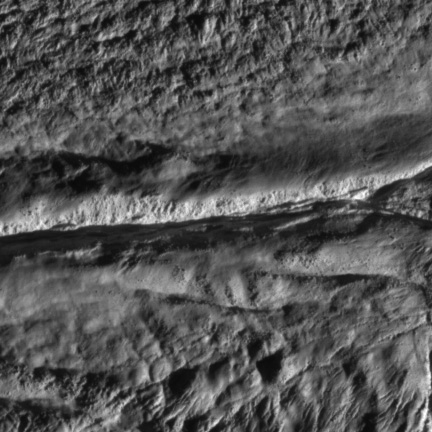 I am no scientist, but I would think that the wispy soft lines billowing from this fracture on Enceladus are the famed geysers we have seen so much of from a distance (see the upper right side of the fracture in particular). The geysers have been easily seen from more distant and back-lit images taken of Enceladus, and we know this area being imaged is the source. So wouldn’t it be fairly safe to assume that it is happening in several of these frames?
I am no scientist, but I would think that the wispy soft lines billowing from this fracture on Enceladus are the famed geysers we have seen so much of from a distance (see the upper right side of the fracture in particular). The geysers have been easily seen from more distant and back-lit images taken of Enceladus, and we know this area being imaged is the source. So wouldn’t it be fairly safe to assume that it is happening in several of these frames?
It may just be that the particles are too fine to be seen at this distance. Consider that they previously have only visible at greater distances when the plumes are back-lit in low-light situations. Seeing this activity from this distance may be kind of like trying to see a cloud when you are already in it… only harder.
Enceladus at Closest Approach!
More Enceladus from Around 2000 km
Enceladus from 17,495 km
Another Enceladus Pass: Aug 11
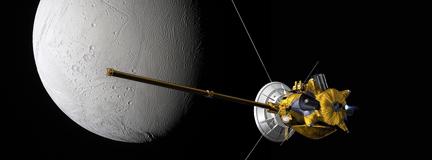 Its been slow around here lately, but the Aug 11 planned close flyby of Enceladus should spice things up a bit. Cassini is now in it’s extended mission and Enceladus has been made a secondary target for the coming months with the primary target being the continued exploration of Titan.
Its been slow around here lately, but the Aug 11 planned close flyby of Enceladus should spice things up a bit. Cassini is now in it’s extended mission and Enceladus has been made a secondary target for the coming months with the primary target being the continued exploration of Titan.
Argh
“Evidence of Soil Habitability Inconclusive.”
See The Planetary Blog on the results from Phoenix. Results could actually be the opposite of what we are hoping for…
Life Online
“Many people -- including, I must admit, me -- took this sentence to mean that a special briefing had taken place, alerting the White House to some positive news about life on Mars.”
Emily Lakdawalla comments on the Phoenix hub-bub which may have been over-blown.
Life On Mars
“It would appear that the US President has been briefed by Phoenix scientists about the discovery of something more "provocative" than the discovery of water existing on the Martian surface.”
Emily Lakdawalla of the Planetary Society will host a web stream on this matter Wednesday night.
More Exposed Martian Ice
What is on Phoenix’s Leg?
 I cannot stop looking at this animation. The first frame was taken on the 8th sol (a Mars day) and the second around the 31st sol. As you can see from the animation, it seems that some mystery material is either growing, moving or multiplying around one of the legs of the Phoenix lander. The most likely source is frost building up on what would be a very cold surface, however the only issue is that it doesn’t look exactly like frost and it hasn’t appeared on any of the other legs.
I cannot stop looking at this animation. The first frame was taken on the 8th sol (a Mars day) and the second around the 31st sol. As you can see from the animation, it seems that some mystery material is either growing, moving or multiplying around one of the legs of the Phoenix lander. The most likely source is frost building up on what would be a very cold surface, however the only issue is that it doesn’t look exactly like frost and it hasn’t appeared on any of the other legs.
Image note: We added an artificial fade from 1 frame to frame 2 and scaled the original image to around 300%. Due to artifacts from increasing the scale and compression we added some noise to smooth out the overall appearance.
Martian Soil Could Support Life
 It looks like Phoenix is finding results with chemistry analysis tests that suggest Martian soil could - or could have supported life. We have known for a while now that elements like magnesium, sodium, potassium and chlorine are all found in Martian soil. Now we also know that the soil alkalinity is comparable to that which we grow all kinds of plants in here on Earth.
It looks like Phoenix is finding results with chemistry analysis tests that suggest Martian soil could - or could have supported life. We have known for a while now that elements like magnesium, sodium, potassium and chlorine are all found in Martian soil. Now we also know that the soil alkalinity is comparable to that which we grow all kinds of plants in here on Earth.
There are more tests to be done, but these results could make growing vegetables in Martian soil a reality one day. It also makes it more conceivable that some kind of life may one day have existed on Mars… or even currently.
The Phoenix Ice Melt
 Thank you… its just what we came for. Now, can we have that in a glass or perhaps with some bacteria?
Thank you… its just what we came for. Now, can we have that in a glass or perhaps with some bacteria?
STS-124: Arm & Crescent
Pssst… Look Under Your Feet
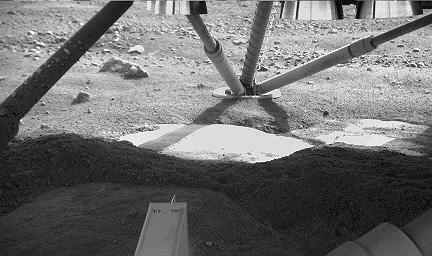 The Mars Phoenix Lander was sent on its long mission to Mars for really one purpose: to find ice. The region selected was seen as one of the more likely places on Mars to have an ice table that is closer to the surface and hopefully available to its robotic arm deployed just a few days ago.
The Mars Phoenix Lander was sent on its long mission to Mars for really one purpose: to find ice. The region selected was seen as one of the more likely places on Mars to have an ice table that is closer to the surface and hopefully available to its robotic arm deployed just a few days ago.
The above image was taken yesterday by that robotic arm and lead scientists suspect that the bright patch visible in the image is the very ice they have been looking for. It would seem that when Phoenix’s thrusters were fired to slow the lander down for a soft touch-down – that all the dust and soil below it was blown away to reveal a smooth and highly reflective surface.
It is not yet official… but this could mean mission accomplished for Phoenix.
The Phoenix Landing Image in Context
Near True Color From Phoenix
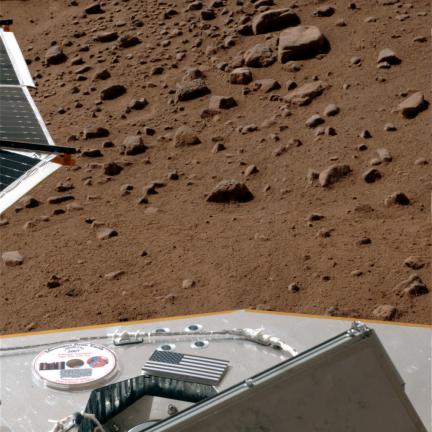 Near “true” color made by Gordan Ugarkovic using the only RED, GREEN and BLUE filtered images returned from the mission thus far. Additional adjustments were made by looking at the logo and the American flag (which we have an idea of what those color are supposed to look like) and adjusting the color of those items to appear as what we know are “true colors”. Logic then dictates that if those items are correctly balanced, then the Martian soil will also appear close to accurate.
Near “true” color made by Gordan Ugarkovic using the only RED, GREEN and BLUE filtered images returned from the mission thus far. Additional adjustments were made by looking at the logo and the American flag (which we have an idea of what those color are supposed to look like) and adjusting the color of those items to appear as what we know are “true colors”. Logic then dictates that if those items are correctly balanced, then the Martian soil will also appear close to accurate.
Phoenix Landing as Seen by Mars Recon
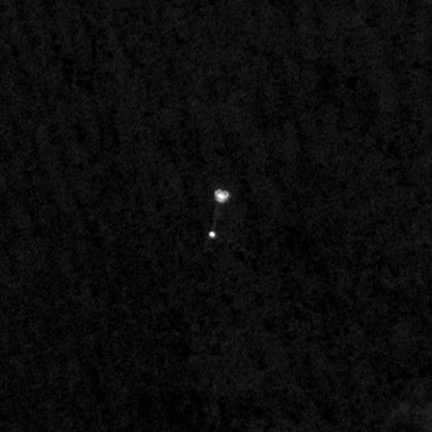 This image represents the very first time we have been able to acquire a visual on any kind of probe landing on the surface of another moon/planet. What is (clearly) seen here is the Mars Phoenix lander in the parachute phase of its descent. You can even make out the shape of the thin threads that hold Phoenix tethered to its chute.
This image represents the very first time we have been able to acquire a visual on any kind of probe landing on the surface of another moon/planet. What is (clearly) seen here is the Mars Phoenix lander in the parachute phase of its descent. You can even make out the shape of the thin threads that hold Phoenix tethered to its chute.
Normally a visit to another world is a solitary experience, but as many as 3 other probes already in orbit around Mars (Mars Reconnaissance, Mars Express and Mars Odyssey) were timed out to be in the general overhead vicinity of the Phoenix landing. It just so happens that one of them, Mars Recon, has very sharp eyes.
